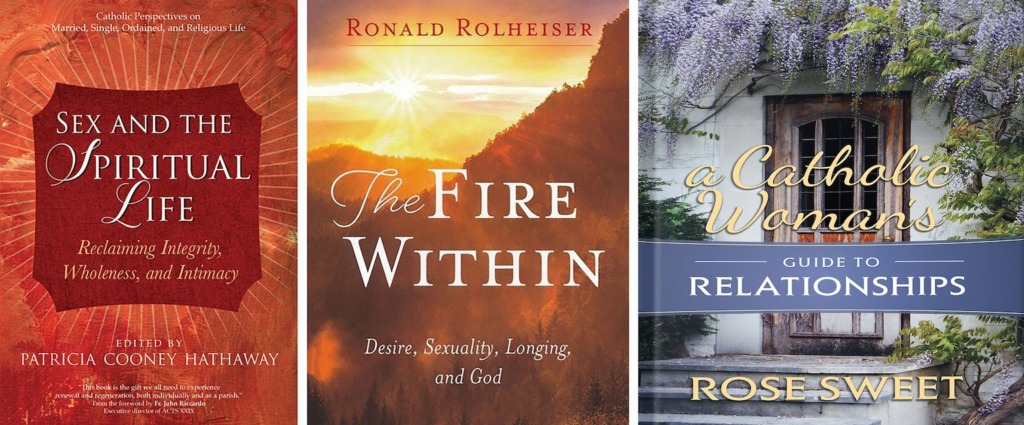“Sex and the Spiritual Life: Reclaiming Integrity, Wholeness and Intimacy,” edited by Patricia Cooney Hathaway. Ave Maria Press (Notre Dame, Indiana, 2020). 185 pp., $18.95.
“The Fire Within: Desire, Sexuality, Longing and God” by Ronald Rolheiser. Paraclete Press (Brewster, Massachusetts, 2021). 96 pp., $15.99.
“A Catholic Woman’s Guide to Relationships” by Rose Sweet. Tan Books (Gastonia, North Carolina, 2020). 188 pp., $19.95.
When it comes to sexuality and relationships, both our culture and at times our Church do a poor job of helping us form healthy attitudes. And linking these realities to our spirituality is something that many of us can’t imagine.
These three books help us to make healthy connections between sexuality and spirituality in unique and complementary ways.
Rose Sweet sets the tone for this conversation through an interesting combination of storytelling, common-sense advice and an occasional Scripture passage that will be helpful for some women.
For example, she comments, “It’s no mystery that we crave relationship. God has revealed himself to be a loving relationship between divine persons. And from that relationship, we were created to be in sweet, perfect relationship with him — and all others who end up in that embrace — forever. We belong there. And we don’t have to wait for heaven to begin to experience the safety, comfort, joy and blessings of that relationship.”
Oblate Father Ronald Rolheiser, in his own inimitable style, powerfully invites the reader to consider the full range of the human experience and how and where we experience God’s presence.
He explains, “Sexuality is inside us to help lure us back to God, bring us into a community of life with each other and let us take part in God’s generativity. If that is true, and it is, then given its origin and meaning, its earthiness notwithstanding, sex does not set us against what is holy and pure. It is a Godly energy.”
He notes that his book consists of fragments, largely taken from his newspaper columns, meant to inspire readers to see deeper connections in their lives, rather than a systematic treatment of the topic.
Whether Father Rolheiser is talking about sex as sacrament (one of his chapters) or about the hidden gift of our pain and loneliness at times, he does indeed make us think.
He observes, “We aren’t persons who live in habitual spiritual awareness who occasionally get distracted. We’re persons who live in habitual distraction who occasionally become spiritually aware. We tend to be so preoccupied with the ordinary business of living that it takes a hurricane of some sort for God to break through.”
While Sweet and Father Rolheiser help the reader with attitudes and openness to relationships and sexuality, Patricia Cooney Hathaway and her essayists help us to see a breathtaking view of the variety of life situations in which to address the beauty and complexity of human sexuality.
Unlike many collections, the essays are all excellent in looking at most aspects of lived sexuality today. In the introduction Hathaway states that the Church has not given us a healthy and robust approach to sexuality.
She observes, “When an energy as powerful as our sexual drive is not given constructive outlets or guidelines, other than being viewed as an occasion of sin, it tends to go underground and emerge in ways that are hurtful to us, to others and to our relationship with God: sexual trafficking and abuse, hookups (sex disconnected from love and relationship), and a wide variety of sexual addictions, including pornography addiction.”
Hathaway explains what she calls spiritualistic dualism, seeing the spirit as good and the body as bad, which is not how Jesus lived but has had a big impact on Christian thinking about sexuality, which she defines as “being in the world as gendered persons.”
In the essay on sexual integrity, defined by St. John Paul II to mean that “a person knows the truth about the meaning of sexuality, can abide by that truth and joyfully acts in accord with that truth,” the topics of pornography and addiction are dealt with in clear and specific ways.
There also are honest and frank essays on marriage — “As long as we saw our sexual desire as a disordered biological urge, and not a God-given gift, this conflict led to a downward spiral that was marked by mutual resentment and frustration” — and single and gay lifestyles. From the latter essay: “Individual sexual integrity rests on the assurance that no one is single — all of us have a Lover who is more faithful than we could ever hope. … No one lives individual sexual integrity perfectly. Our communal sexual integrity is even rarer, requiring an even deeper surrender to God. It is also, for this reason, more precious.”
Other essays look at sexuality for vowed religious, deacons and seminarians.
There is even an essay here about the diocesan priesthood, written by a bishop who tellingly observes, “When I have had to remove a priest from active ministry for the sexual abuse of a minor or a vulnerable adult, I find that none of these priests are receiving direction from a spiritual director who holds him accountable. Consequently, these priests wind up doing priestly functions without a priestly heart that is fixed in the heart of Jesus Christ.”
Hathaway concludes with several recommendations about the intersection between sex and the spiritual life, especially the importance of friendship and community, as well as prayer and the sacraments. She has given the Church a valuable resource indeed.
Finley is the author of several books on practical spirituality, including “The Liturgy of Motherhood: Moments of Grace” and “Savoring God: Praying With All Our Senses,” and has just finished teaching in the religious studies department at Gonzaga University.

